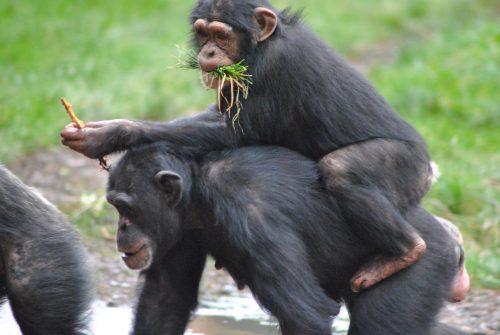Small children and chimpanzees share some innate abilities
Jason G. Goldman, The article is published with the approval of Scientific American Israel and the Ort Israel network, 24.07.2016

In the heart After all, Mahela In the greens of Tanzania, a chimpanzee plucks the leaves from a small branch she holds in her hand and then sticks the branch in the ground. When she pulls the branch out, it serves her a delicious meal of termites crawling along it in droves. The chimpanzee licks the insects greedily and then sticks the branch in the ground to hunt for more of those snacks.
On the other side of the world, a three-year-old British boy sits on the floor with a cardboard box in front of him. Three sponges are visible through a small hole in the box. If he succeeds in extracting the sponges from the box, he will win a sticker. Without receiving instructions on how to do this, the boy decides to take a wooden stick coated with scotch tape that is lying next to him. Logic tells him that the sponges will probably stick to the scotch tape, and he is right. Soon he succeeds in the task and wins the prize.
in the first case the primate Tanzania is just going about its daily routine. In contrast, the British primate is participating in an experiment aimed at investigating whether the use of certain tools is instinctive.
The similarities between the two examples are not accidental. The purpose of the British study was to make a comparison between the cognitive abilities of us, humans, and those of our ape relatives, based on behaviors related to the use of tools observed among chimpanzees and orangutans living in the wild. Behaviors in nature serve as a model for examining similar behaviors among small children. In the study, which was conducted on a sample of 50 toddlers aged two to three and a half years, behaviors related to the use of tools were observed with a frequency similar to that found among chimpanzees and orangutans living in the wild. Similar behaviors to those common among monkeys, such as termite hunting, are also often observed among children. At the same time, behaviors that are rarer in communities of monkeys living in the wild, such as using a stone to crack a nut shell, were also observed less often among the toddlers. In total, the children in the sample group succeeded in 11 of the 12 test tasks. the psychologist Eva Reindl, who led the study, says that the fact that the toddlers demonstrated the expected behavior is evidence of their instinctive ability, inherent in them from birth, to use these simple tools.
The research findings, Released In the records of the British Royal Society, they challenge the popular opinion that children do not know how to use tools and must always learn to do so. - a claim put forward by the Soviet psychologist at the beginning of the 20th century Lev Vygotsky, who wrote in 1930 that in human society, the spontaneous use of tools by children "aspires to zero".
The research findings also show that we, humans, and our relatives, the great apes, apparently share an innate cognitive mechanism that allows us to recognize and understand the physical world around us and manipulate it skillfully.

One response
It is not clear to me what the instinctive skills of human children are,
or what is the evidence for their instinctive ability to use tools,
But according to all the observations and studies, other primates learn the use of tools, they learn, that is: they do not have an "inherent instinctive ability",
Therefore the conclusions are not based...